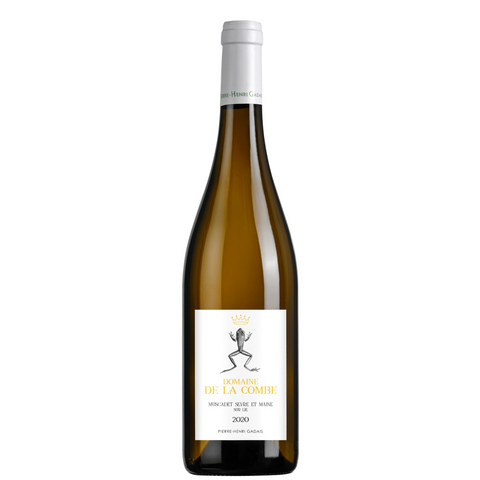
2022 Domaine de la Combe Muscadet Sevre et Maine sur Lie, Loire Valley, France
Crisp, fresh super classic Muscadet!! Flinty characteristics with lemon-fresh acidity and green apple notes followed by hints of yeasty lees mouthfeel leaving your mouth watering and craving that next sip!
There are 28 units left in stock.
ABOUT THIS WINE
In the village of Saint-Fiacre, in the cradle of the appellation between the iconic rivers of “Sèvre” and “Maine”, at the lieux dit, la Pétière. It is a blend of most of the plots of the domaine, subsoil are : schist, Orthogneiss and Gneiss à 2 Mica. As the domaine’s geology is a “Combe”, the vines benefits multiples exposures with a 45 meters elevation plate, a south exposure slop and a northern exposure slope.
Harvested at the optimum maturity, grapes are directly pressed before the juice goes in tanks by gravity. The juice doesn’t receive any sulfites till the end of the fermentation. Fermentation is complete by the wild yeast of the vineyard. As the malolactic fermentation is not suitable for my terroir, sulfites are added only once, right before the aging. That process permit to significantly decrease the amount of sulfites. It is a minimum intervention wine. Aged for 8 months on the winemaking lees, with regular batonnage all along the winter season.
ABOUT THIS PRODUCER
In the village of Saint-Fiacre-sur-Maine, on the banks of the Sèvre, not far from its union with the Maine, Pierre-Henri Gadais of Domaine de la Combe is producing some of the most exciting wines coming out of the Muscadet region today.
Descended from the Bourgeois family (Domaine Henri Bourgeois) in Sancerre on his mother’s side and the fifth generation of the Gadais family (Gadais Père et Fils) to produce wine from the rolling hills surrounding Saint-Fiacre-sur-Maine, Pierre-Henri was perhaps destined to be a vigneron. In the Muscadet region the Gadais family has long been synonymous with high quality production, with legendary importers Frank Schoonmaker, Robert Chadderdon, and now Peter Weygandt bringing the wines of Gadais family to the United States.
Growing up in the vines and cellar of his father and grandfather, Pierre-Henri received quite the education from a very early age. It would have been easy to return to the family Domaine after earning his Viticulture & Enology degree in Burgundy, but Pierre-Henri chose a different path. To gain a better understanding of the international wine trade, he studied Wine Business in Bordeaux for 2 years, followed by a year in California working in wine distribution. After the completion of his studies, Pierre-Henri worked for several years as an apprentice winemaker in Australia, Switzerland, Burgundy, Pomerol, Sancerre, and back in Muscadet at Domaine de la Pépière.
Finally in 2016 he returned to Saint-Fiacre-sur-Maine to work with his father Christophe at Gadais Père et Fils. However, simply coming into the family business was not enough for the talented young vigneron and soon Pierre-Henri was looking to start a project of his own. The perfect opportunity came in the form of Les Grands Presbytères, a nine-hectare Domaine started in the 1920’s by the Marzelleau family. In 2009 Nelly Marzelleau, the current generation, was looking to step back from the day to day running of Les Grands Presbytères and contracted with her neighbor, Christophe Gadais, to farm the vineyards and make the wines. From the 2009 to 2015 vintage, Christophe Gadais made the wines for the Marzelleau family under the Les Grands Presbytères label. In 2016, with the blessing of his father, Pierre-Henri purchased the vines and the cellar, rechristening it Domaine de la Combe.
Immediately Pierre-Henri began the task of enhancing the unique terroir and reorganizing the Domaine towards the production of multiple quality-oriented cuvees. He later added some adjoining parcels, bringing the total to 15 hectares. Domaine de la Combe is unique in that all the Domaine’s vines are in a single block. The vines lie within the lieu dit of La Pétière, and rest on a gentle hillside known as the Butte de la Combe. There are 3 distinct terroirs in the Butte de la Combe: orthogneiss on the summit, gneiss on the southern slopes, and schist on the northern slopes. The Domaine has a good mix of young and old vines with the oldest being planted in the 1950’s and youngest as recent as 2016. The spraying of herbicides and pesticides was stopped in 2016 and the conversion to Organic viticulture began in 2017. Work in the vines is done according to the lunar cycle and, as of the 2021 vintage, all the Domaine’s holdings are certified Organic.
In the cellar, much is done in a traditional way with vinification and long ageing on the lees in subterranean glass tanks. However, there are also notable differences. Unlike many of his counterparts in the region who inoculate with cultivated yeasts, Pierre-Henri relies solely on wild indigenous yeasts for a spontaneous, natural fermentation. Work in the cellar is done according to the lunar cycle, and only one sulfur addition is made at the completion of alcoholic fermentation. A light filtration is made prior to bottling to avoid further sulfur additions. Pierre-Henri has also begun to experiment with oak ageing (Vigne de l’Astrée), light skin contact (Vendange Nocturne), and vinification without the additional of sulfur (Zeste).
Details:
| Grape(s) | Melon de Bourgogne |
| Farming | Organic |
